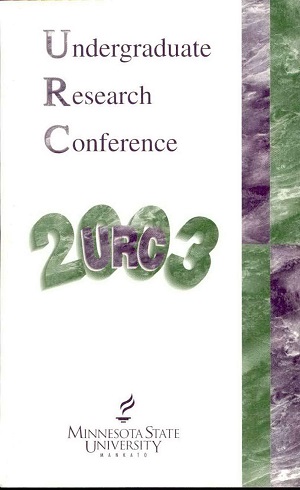Identification of Specific Phenol Hydroxylase Genes in Freshwater Bacterial Isolates
Location
CSU
Student's Major
Biological Sciences
Student's College
Science, Engineering and Technology
Mentor's Name
Elaine O. Hardwick
Mentor's Department
Biological Sciences
Mentor's College
Science, Engineering and Technology
Description
The purpose of this experiment is to detect the presence of phenol hydroxylase (LmPH) genes in phenol-degrading bacteria in Ox Bow Lake (Mankato, MN) and to examine whether one or more of three specific LmPH gene sequences are present. Detection and identification of the f LmPH genes can be accomplished using Polymerase Chain Reaction (PGR) with known primers of LmPH genes. Phenol is used as a precursor of many organic compounds and is one of the common pollutants in the aquatic environment. Some aquatic bacteria can utilize phenolcontaining compounds found in decaying plant materials as ^ a carbon and energy source. These bacteria could be used in bioremediation of phenol-polluted environments. LmPH is suggested to be the most common bacterial phenol- degrading enzyme system. The LmPH genes can be separated into three groups (I, II, and III) based on the PGR analysis of bacterial DNA. Twelve freshwater bacteria previously isolated from Ox Bow Lake, were identified as phenol-degraders since they could use phenol as a sole carbon and energy source
Identification of Specific Phenol Hydroxylase Genes in Freshwater Bacterial Isolates
CSU
The purpose of this experiment is to detect the presence of phenol hydroxylase (LmPH) genes in phenol-degrading bacteria in Ox Bow Lake (Mankato, MN) and to examine whether one or more of three specific LmPH gene sequences are present. Detection and identification of the f LmPH genes can be accomplished using Polymerase Chain Reaction (PGR) with known primers of LmPH genes. Phenol is used as a precursor of many organic compounds and is one of the common pollutants in the aquatic environment. Some aquatic bacteria can utilize phenolcontaining compounds found in decaying plant materials as ^ a carbon and energy source. These bacteria could be used in bioremediation of phenol-polluted environments. LmPH is suggested to be the most common bacterial phenol- degrading enzyme system. The LmPH genes can be separated into three groups (I, II, and III) based on the PGR analysis of bacterial DNA. Twelve freshwater bacteria previously isolated from Ox Bow Lake, were identified as phenol-degraders since they could use phenol as a sole carbon and energy source



